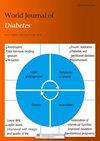Roles of fibroblast growth factors in the treatment of diabetes.
IF 4.6
3区 医学
Q1 ENDOCRINOLOGY & METABOLISM
引用次数: 0
Abstract
Diabetes affects about 422 million people worldwide, causing 1.5 million deaths each year. However, the incidence of diabetes is increasing, including several types of diabetes. Type 1 diabetes (5%-10% of diabetic cases) and type 2 diabetes (90%-95% of diabetic cases) are the main types of diabetes in the clinic. Accumulating evidence shows that the fibroblast growth factor (FGF) family plays important roles in many metabolic disorders, including type 1 and type 2 diabetes. FGF consists of 23 family members (FGF-1-23) in humans. Here, we review current findings of FGFs in the treatment of diabetes and management of diabetic complications. Some FGFs (e.g., FGF-15, FGF-19, and FGF-21) have been broadly investigated in preclinical studies for the diagnosis and treatment of diabetes, and their therapeutic roles in diabetes are currently under investigation in clinical trials. Overall, the roles of FGFs in diabetes and diabetic complications are involved in numerous processes. First, FGF intervention can prevent high-fat diet-induced obesity and insulin resistance and reduce the levels of fasting blood glucose and triglycerides by regulating lipolysis in adipose tissues and hepatic glucose production. Second, modulation of FGF expression can inhibit renal and cardiac fibrosis by regulating the expression of extracellular matrix components, promote diabetic wound healing process and bone repair, and inhibit cancer cell proliferation and migration. Finally, FGFs can regulate the activation of glucose-excited neurons and the expression of thermogenic genes.成纤维细胞生长因子在糖尿病治疗中的作用。
全世界约有 4.22 亿人患有糖尿病,每年造成 150 万人死亡。然而,糖尿病的发病率正在上升,其中包括多种类型的糖尿病。1 型糖尿病(占糖尿病病例的 5%-10%)和 2 型糖尿病(占糖尿病病例的 90%-95%)是临床上主要的糖尿病类型。越来越多的证据表明,成纤维细胞生长因子(FGF)家族在包括 1 型和 2 型糖尿病在内的许多代谢性疾病中发挥着重要作用。在人类中,成纤维细胞生长因子由 23 个家族成员(FGF-1-23)组成。在此,我们回顾了目前有关 FGFs 在治疗糖尿病和控制糖尿病并发症方面的研究成果。一些 FGFs(如 FGF-15、FGF-19 和 FGF-21)已在临床前研究中被广泛用于糖尿病的诊断和治疗,它们在糖尿病中的治疗作用目前正在临床试验中进行研究。总体而言,FGFs 在糖尿病和糖尿病并发症中的作用涉及多个过程。首先,通过调节脂肪组织的脂肪分解和肝糖生成,干预 FGF 可预防高脂饮食引起的肥胖和胰岛素抵抗,降低空腹血糖和甘油三酯水平。其次,调节 FGF 的表达可通过调节细胞外基质成分的表达抑制肾脏和心脏纤维化,促进糖尿病伤口愈合过程和骨修复,抑制癌细胞增殖和迁移。最后,成纤维细胞生长因子可以调节葡萄糖激发神经元的活化和产热基因的表达。
本文章由计算机程序翻译,如有差异,请以英文原文为准。
求助全文
约1分钟内获得全文
求助全文
来源期刊

World Journal of Diabetes
ENDOCRINOLOGY & METABOLISM-
自引率
2.40%
发文量
909
期刊介绍:
The WJD is a high-quality, peer reviewed, open-access journal. The primary task of WJD is to rapidly publish high-quality original articles, reviews, editorials, and case reports in the field of diabetes. In order to promote productive academic communication, the peer review process for the WJD is transparent; to this end, all published manuscripts are accompanied by the anonymized reviewers’ comments as well as the authors’ responses. The primary aims of the WJD are to improve diagnostic, therapeutic and preventive modalities and the skills of clinicians and to guide clinical practice in diabetes. Scope: Diabetes Complications, Experimental Diabetes Mellitus, Type 1 Diabetes Mellitus, Type 2 Diabetes Mellitus, Diabetes, Gestational, Diabetic Angiopathies, Diabetic Cardiomyopathies, Diabetic Coma, Diabetic Ketoacidosis, Diabetic Nephropathies, Diabetic Neuropathies, Donohue Syndrome, Fetal Macrosomia, and Prediabetic State.
 求助内容:
求助内容: 应助结果提醒方式:
应助结果提醒方式:


